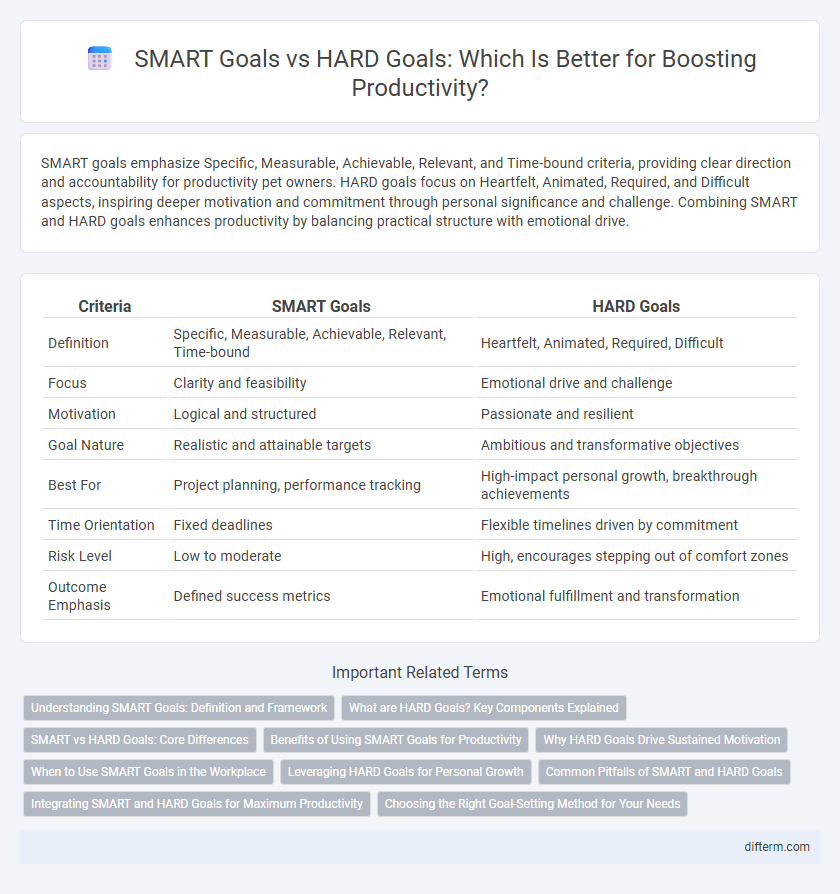SMART goals emphasize Specific, Measurable, Achievable, Relevant, and Time-bound criteria, providing clear direction and accountability for productivity pet owners. HARD goals focus on Heartfelt, Animated, Required, and Difficult aspects, inspiring deeper motivation and commitment through personal significance and challenge. Combining SMART and HARD goals enhances productivity by balancing practical structure with emotional drive.
Table of Comparison
| Criteria | SMART Goals | HARD Goals |
|---|---|---|
| Definition | Specific, Measurable, Achievable, Relevant, Time-bound | Heartfelt, Animated, Required, Difficult |
| Focus | Clarity and feasibility | Emotional drive and challenge |
| Motivation | Logical and structured | Passionate and resilient |
| Goal Nature | Realistic and attainable targets | Ambitious and transformative objectives |
| Best For | Project planning, performance tracking | High-impact personal growth, breakthrough achievements |
| Time Orientation | Fixed deadlines | Flexible timelines driven by commitment |
| Risk Level | Low to moderate | High, encourages stepping out of comfort zones |
| Outcome Emphasis | Defined success metrics | Emotional fulfillment and transformation |
Understanding SMART Goals: Definition and Framework
SMART goals are a productivity framework that stands for Specific, Measurable, Achievable, Relevant, and Time-bound objectives designed to enhance clarity and focus. This approach ensures goals are clearly defined and trackable, promoting accountability and motivation throughout the process. Implementing SMART goals improves project management and personal productivity by providing structured milestones and deadlines.
What are HARD Goals? Key Components Explained
HARD goals stand for Heartfelt, Animated, Required, and Difficult, emphasizing emotional connection and motivation in goal setting. These goals drive personal commitment by aligning with core values and visualizing success vividly. Incorporating HARD goals into productivity strategies enhances perseverance and engagement beyond traditional SMART goals.
SMART vs HARD Goals: Core Differences
SMART goals emphasize Specificity, Measurability, Achievability, Relevance, and Time-bound criteria, ensuring clear and structured progress tracking. HARD goals focus on Heartfelt desires, Animated visualization, Required effort, and Difficulty, promoting motivation and emotional engagement. The core difference lies in SMART goals' analytical approach versus HARD goals' emotional and challenge-driven focus.
Benefits of Using SMART Goals for Productivity
SMART goals enhance productivity by providing clear, specific, and measurable targets that improve focus and motivation, ensuring tasks are achievable within defined timeframes. This structured approach facilitates consistent progress tracking and timely adjustments, reducing ambiguity and procrastination. Emphasizing realistic and time-bound objectives helps maintain accountability and drives efficient resource allocation toward desired outcomes.
Why HARD Goals Drive Sustained Motivation
HARD goals--Heartfelt, Animated, Required, and Difficult--drive sustained motivation by engaging emotional commitment and a clear sense of purpose, unlike SMART goals which focus mainly on specificity and measurability. Psychological studies show that HARD goals activate intrinsic motivation, leading to greater persistence and long-term achievement. This emotional investment fosters resilience, making it easier to overcome obstacles and maintain consistent productivity over time.
When to Use SMART Goals in the Workplace
SMART goals are ideal in the workplace for projects requiring clear, measurable outcomes and structured timelines, ensuring employees stay focused and accountable. They work best during performance evaluations, process improvements, and deadline-driven tasks where specificity and trackability drive success. Emphasizing Specific, Measurable, Achievable, Relevant, and Time-bound criteria promotes clarity and consistent progress monitoring.
Leveraging HARD Goals for Personal Growth
Leveraging HARD goals--Heartfelt, Animated, Required, and Difficult--can drive deeper personal growth by aligning objectives with intrinsic motivation and emotional engagement. Unlike SMART goals, which emphasize specificity and measurability, HARD goals challenge individuals to embrace passion and persistence, fostering resilience and long-term transformation. This approach enhances productivity by cultivating a growth mindset focused on meaningful, high-impact achievements.
Common Pitfalls of SMART and HARD Goals
SMART goals often falter due to their rigid specificity, which can limit flexibility and creativity, leading to demotivation when unexpected challenges arise. HARD goals risk overwhelming individuals by setting overly ambitious targets that may cause burnout or frustration if progress feels unattainable. Both frameworks can suffer from a lack of adaptability and emotional engagement, reducing long-term productivity when goals are either too constrained or excessively demanding.
Integrating SMART and HARD Goals for Maximum Productivity
Integrating SMART (Specific, Measurable, Achievable, Relevant, Time-bound) goals with HARD (Heartfelt, Animated, Required, Difficult) goals enhances productivity by balancing precision and emotional motivation. SMART goals provide clear benchmarks and timelines, while HARD goals foster passion and determination, driving sustained effort. Combining both frameworks creates a dynamic goal-setting strategy that maximizes focus, commitment, and achievement in personal and professional productivity.
Choosing the Right Goal-Setting Method for Your Needs
SMART goals--Specific, Measurable, Achievable, Relevant, Time-bound--offer clear structure ideal for those seeking concrete benchmarks and deadlines. HARD goals--Heartfelt, Animated, Required, and Difficult--drive motivation through emotional connection and challenge, suited for individuals focused on personal growth and inspiration. Selecting between SMART and HARD goals depends on whether you prioritize precise metrics or intrinsic motivation to enhance productivity effectively.
SMART goals vs HARD goals Infographic

 difterm.com
difterm.com